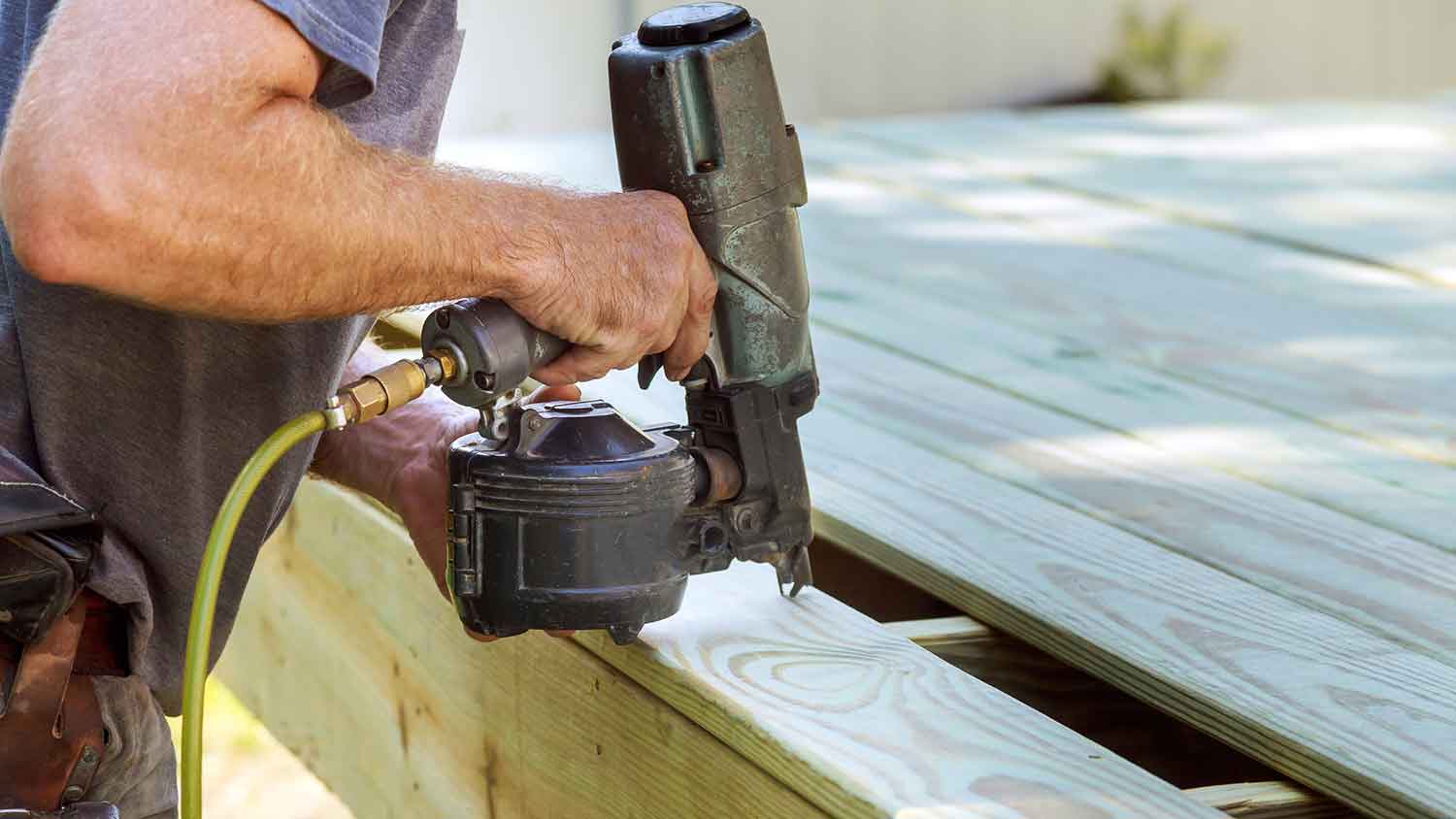
The cost to paint a house's exterior depends on its size, siding type, and height. The finish and the home's exterior condition also play a role.
Balance beauty and durability, one coat at a time


Deck stain protects wood and shows off the natural wood grain.
Compared to paint, deck stain is more affordable.
Prepping your deck for stain by sanding and cleaning will deliver better results.
There are several alternatives to deck stain, including paint, oil, and sealant.
When it comes to enhancing the beauty and longevity of your outdoor space, few methods rival the transformative power of staining a deck. From adding rich hues that amplify the natural allure of wood to providing a protective shield against the elements, deck staining boasts many benefits. However, achieving these advantages requires preparation and regular upkeep. Let’s explore the pros and cons of staining a deck.
Deck stain is a specialized coating applied to wooden decks to enhance their appearance and protect them from environmental damage. Unlike paint, which coats the surface, deck stain penetrates the wood, highlighting its natural grain and texture. It comes in various opacities, from transparent to solid, and a wide range of colors, allowing homeowners to accentuate the wood's natural beauty or alter its hue.
Additionally, deck stain contains additives that shield the wood from harmful UV rays, moisture, mildew, and other elements, prolonging the deck's life span. This versatile solution offers aesthetic appeal and functional protection, making it popular for maintaining and beautifying outdoor living spaces.
| Pros | Cons |
|---|---|
| Enhances appearance | Prep work |
| Protective barrier | Limited coverage |
| Lasts 3 to 5 years | Requires maintenance |
| Different colors | Colors fade |
| Cost-effective | Labor intensive |

Overall, staining a deck offers numerous benefits in terms of appearance and protection.
Deck stain enhances the beauty of wood by accentuating its characteristics while adding depth and richness to its appearance. Unlike paint, which conceals the wood's grain and texture, stain allows these features to shine through, highlighting the unique patterns and colors inherent in different wood species. Additionally, stains can deepen or refine the wood's natural color, giving it a more luxurious appearance.
Staining creates a protective barrier from the elements by penetrating deep into the wood fibers and forming a seal on the surface. This seal protects against moisture, UV rays, mold, mildew, and other environmental factors that can damage the wood over time. By preventing moisture from seeping into the wood, stain helps reduce the risk of rot, warping, and cracking, extending the deck's life span.
Maintaining the optimal appearance of wooden decks involves reapplying a fresh stain every few years and a sealer annually. However, the longevity of your deck's pristine look depends on the type of stain employed. Clear stains may need touch-ups every year or two, whereas solid or oil-based stains have the potential to endure for five years or longer without reapplication.
Deck stain options offer a wide range of hues, from classic browns to bold blues and refreshing greens. Though brown is still a popular choice, homeowners looking for a colorful look without sacrificing the appearance of the wood grain can add bold or subtle color to their deck as they could with paint.
Compared to the cost of painting a deck, $500 to $2,000, staining is more cost-effective. The average cost to stain a deck is $550 to $1,250, depending on your location and the surface size. Remember that speaking with a local deck staining professional is always a good idea to obtain labor accurate costs.

While deck stain offers numerous benefits in enhancing aesthetics and protecting wood, we would be remiss for not acknowledging potential downsides.
Simply put, there are no shortcuts in staining. Prep work for staining a deck extends beyond cleaning and sanding; it often involves inspecting the wood for any damages or imperfections that may compromise the staining process or the deck's structural integrity.
Repairing cracks, splits, or loose boards ensures a smooth surface for the stain to adhere to, preventing future issues and prolonging the deck's life span. Additionally, addressing mold or mildew growth with proper cleaning and treatment is just as necessary for preventing these issues from worsening under the stain.
A stain's transparency or opacity determines its ability to conceal imperfections or discolorations in the wood. Unlike paint, which can provide comprehensive coverage and hide flaws, stain allows the natural characteristics of the wood, such as knots, grain patterns, and color variations, to remain visible. While this transparency enhances the deck's natural beauty, it also means that certain imperfections may still be noticeable after staining.
Regular deck maintenance is required to keep your stain looking fresh. The process includes cleaning the deck to prevent stains and mildew and inspecting the wood boards for any damage or loose screws. Many experts also suggest re-sealing your deck yearly to preserve the stain's finish.
Homeowners have several options for enhancing and protecting their outdoor wood surfaces besides staining.
Deck sealer: Providing a transparent protective layer without altering the wood's color, sealer is ideal for showcasing the wood’s natural beauty while offering protection. Deck sealing costs about the same as staining.
Deck paint: Unlike stain, which penetrates the wood, deck paint forms a thick, opaque film on the surface, offering comprehensive coverage in a broad range of colors.
Wood preservatives: Wood preservatives, also known as wood treatments or wood protectors, are applied to the surface to prevent rot, decay, and insect damage.
Linseed oil or tung oil: Both penetrate the wood's surface to nourish and protect it from the inside out while enhancing its natural color and grain—remember, rags soaked in these oils can combust if crumbled and left.
Ultimately, the decision to use deck stain depends on your preferences, the condition of your deck, and your long-term maintenance goals. Stain could be a perfect choice if you value the natural look of wood and want to protect your deck from the elements. Here are more considerations.
Deck type: Stain is best for decks made of natural wood, but it may not be suitable for composite materials. For example, you cannot paint or stain Trex decking.
Climate considerations: Wood stain can protect your deck by sealing out moisture and UV rays in areas with intense sunlight or heavy rainfall.
Budget: Wood stain tends to be more cost-effective than other deck treatments, such as painting, making it an economical option.
From average costs to expert advice, get all the answers you need to get your job done.

The cost to paint a house's exterior depends on its size, siding type, and height. The finish and the home's exterior condition also play a role.

The cost to paint a deck depends on its size, design, and whether you DIY. Read this guide to help set the budget for your deck painting project.

Looking to give your fence a refresh? This guide explores the cost to stain a fence—and the cost to paint it, too— so you can budget for your project.

There isn’t just one best time to stain a deck but a couple, and which you choose will depend on factors like local climate and materials used.

Go step-by-step through how to prep and paint your pool deck for a major upgrade in your backyard oasis.

Painting your front door involves proper preparation, primer, and several coats of paint. Here's everything you need to know about how to paint a front door.